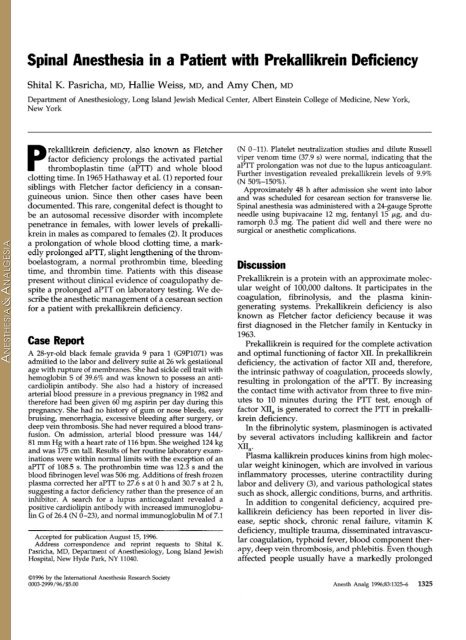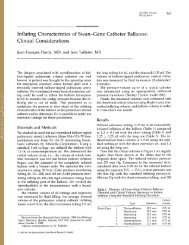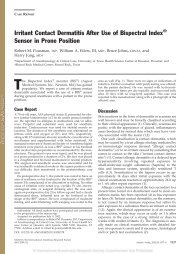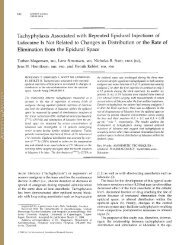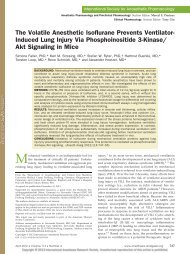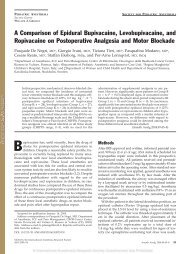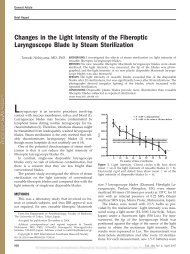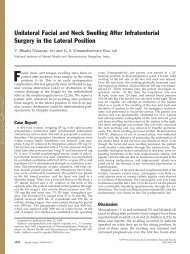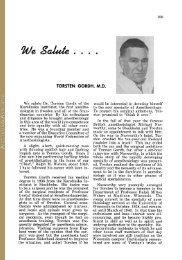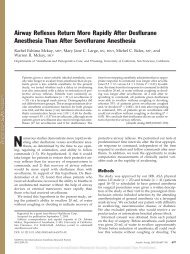Spinal Anesthesia in a Patient with Prekallikrein Deficiency
Spinal Anesthesia in a Patient with Prekallikrein Deficiency
Spinal Anesthesia in a Patient with Prekallikrein Deficiency
Create successful ePaper yourself
Turn your PDF publications into a flip-book with our unique Google optimized e-Paper software.
<strong>Sp<strong>in</strong>al</strong> <strong>Anesthesia</strong> <strong>in</strong> a <strong>Patient</strong> <strong>with</strong> Prekallikre<strong>in</strong> <strong>Deficiency</strong><br />
Shital K. Pasricha, MD, Hallie Weiss, MD, and Amy Chen, MD<br />
Department of Anesthesiology, Long Island Jewish Medical Center, Albert E<strong>in</strong>ste<strong>in</strong> College of Medic<strong>in</strong>e, New York,<br />
New York<br />
P<br />
rekallikre<strong>in</strong> deficiency, also known as Fletcher<br />
factor deficiency prolongs the activated partial<br />
thromboplast<strong>in</strong> time (aPTT) and whole blood<br />
clott<strong>in</strong>g time. In 1965 Hathaway et al. (1) reported four<br />
sibl<strong>in</strong>gs <strong>with</strong> Fletcher factor deficiency <strong>in</strong> a consangu<strong>in</strong>eous<br />
union. S<strong>in</strong>ce then other cases have been<br />
documented. This rare, congenital defect is thought to<br />
be an autosomal recessive disorder <strong>with</strong> <strong>in</strong>complete<br />
penetrance <strong>in</strong> females, <strong>with</strong> lower levels of prekallikre<strong>in</strong><br />
<strong>in</strong> males as compared to females (2). It produces<br />
a prolongation of whole blood clott<strong>in</strong>g time, a markedly<br />
prolonged aPTT, slight lengthen<strong>in</strong>g of the thromboelastogram,<br />
a normal prothromb<strong>in</strong> time, bleed<strong>in</strong>g<br />
time, and thromb<strong>in</strong> time. <strong>Patient</strong>s <strong>with</strong> this disease<br />
present <strong>with</strong>out cl<strong>in</strong>ical evidence of coagulopathy despite<br />
a prolonged aPTT on laboratory test<strong>in</strong>g. We describe<br />
the anesthetic management of a cesarean section<br />
for a patient <strong>with</strong> prekallikre<strong>in</strong> deficiency.<br />
Case Report<br />
A 28-yr-old black female gravida 9 para 1 (G9P1071) was<br />
admitted to the labor and delivery suite at 26 wk gestational<br />
age <strong>with</strong> rupture of membranes. She had sickle cell trait <strong>with</strong><br />
hemoglob<strong>in</strong> S of 39.6% and was known to possess an anticardiolip<strong>in</strong><br />
antibody. She also had a history of <strong>in</strong>creased<br />
arterial blood pressure <strong>in</strong> a previous pregnancy <strong>in</strong> 1982 and<br />
therefore had been given 60 mg aspir<strong>in</strong> per day dur<strong>in</strong>g this<br />
pregnancy. She had no history of gum or nose bleeds, easy<br />
bruis<strong>in</strong>g, menorrhagia, excessive bleed<strong>in</strong>g after surgery, or<br />
deep ve<strong>in</strong> thrombosis. She had never required a blood transfusion.<br />
On admission, arterial blood pressure was 144/<br />
81 mm Hg <strong>with</strong> a heart rate of 116 bpm. She weighed 124 kg<br />
and was 175 cm tall. Results of her rout<strong>in</strong>e laboratory exam<strong>in</strong>ations<br />
were <strong>with</strong><strong>in</strong> normal limits <strong>with</strong> the exception of an<br />
aPTT of 108.5 s. The prothromb<strong>in</strong> time was 12.3 s and the<br />
blood fibr<strong>in</strong>ogen level was 506 mg. Additions of fresh frozen<br />
plasma corrected her aPTT to 27.6 s at 0 h and 30.7 s at 2 h,<br />
suggest<strong>in</strong>g a factor deficiency rather than the presence of an<br />
<strong>in</strong>hibitor. A search for a lupus anticoagulant revealed a<br />
positive cardiolip<strong>in</strong> antibody <strong>with</strong> <strong>in</strong>creased immunoglobul<strong>in</strong><br />
G of 26.4 (N O-23), and normal immunoglobul<strong>in</strong> M of 7.1<br />
Accepted for publication August 15, 1996.<br />
Address correspondence and repr<strong>in</strong>t requests to Shital K.<br />
Pasricha, MD, Department of Anesthesiology, Long Island Jewish<br />
Hospital, New Hyde Park, NY 11040.<br />
01996 by the International <strong>Anesthesia</strong> Research Society<br />
0003-2999/96/$5.00<br />
(N O-11). Platelet neutralization studies and dilute Russell<br />
viper venom time (37.9 s) were normal, <strong>in</strong>dicat<strong>in</strong>g that the<br />
aPTT prolongation was not due to the lupus anticoagulant.<br />
Further <strong>in</strong>vestigation revealed prekallikre<strong>in</strong> levels of 9.9%<br />
(N 50%-150%).<br />
Approximately 48 h after admission she went <strong>in</strong>to labor<br />
and was scheduled for cesarean section for transverse lie.<br />
<strong>Sp<strong>in</strong>al</strong> anesthesia was adm<strong>in</strong>istered <strong>with</strong> a 24-gauge Sprotte<br />
needle us<strong>in</strong>g bupivaca<strong>in</strong>e 12 mg, fentanyl 15 pg, and du-<br />
ramorph 0.3 mg. The patient did well and there were no<br />
surgical or anesthetic complications.<br />
Discussion<br />
Prekallikre<strong>in</strong> is a prote<strong>in</strong> <strong>with</strong> an approximate molec-<br />
ular weight of 100,000 daltons. It participates <strong>in</strong> the<br />
coagulation, fibr<strong>in</strong>olysis, and the plasma k<strong>in</strong><strong>in</strong>-<br />
generat<strong>in</strong>g systems. Prekallikre<strong>in</strong> deficiency is also<br />
known as Fletcher factor deficiency because it was<br />
first diagnosed <strong>in</strong> the Fletcher family <strong>in</strong> Kentucky <strong>in</strong><br />
1963.<br />
Prekallikre<strong>in</strong> is required for the complete activation<br />
and optimal function<strong>in</strong>g of factor XII. In prekallikre<strong>in</strong><br />
deficiency, the activation of factor XII and, therefore,<br />
the <strong>in</strong>tr<strong>in</strong>sic pathway of coagulation, proceeds slowly,<br />
result<strong>in</strong>g <strong>in</strong> prolongation of the aPTT. By <strong>in</strong>creas<strong>in</strong>g<br />
the contact time <strong>with</strong> activator from three to five m<strong>in</strong>-<br />
utes to 10 m<strong>in</strong>utes dur<strong>in</strong>g the PTT test, enough of<br />
factor XII, is generated to correct the PTT <strong>in</strong> prekalli-<br />
kre<strong>in</strong> deficiency.<br />
In the fibr<strong>in</strong>olytic system, plasm<strong>in</strong>ogen is activated<br />
by several activators <strong>in</strong>clud<strong>in</strong>g kallikre<strong>in</strong> and factor<br />
XII,.<br />
Plasma kallikre<strong>in</strong> produces k<strong>in</strong><strong>in</strong>s from high molec-<br />
ular weight k<strong>in</strong><strong>in</strong>ogen, which are <strong>in</strong>volved <strong>in</strong> various<br />
<strong>in</strong>flammatory processes, uter<strong>in</strong>e contractility dur<strong>in</strong>g<br />
labor and delivery (3), and various pathological states<br />
such as shock, allergic conditions, burns, and arthritis.<br />
In addition to congenital deficiency, acquired pre-<br />
kallikre<strong>in</strong> deficiency has been reported <strong>in</strong> liver dis-<br />
ease, septic shock, chronic renal failure, vitam<strong>in</strong> K<br />
deficiency, multiple trauma, dissem<strong>in</strong>ated <strong>in</strong>travascu-<br />
lar coagulation, typhoid fever, blood component ther-<br />
apy, deep ve<strong>in</strong> thrombosis, and phlebitis. Even though<br />
affected people usually have a markedly prolonged<br />
Anesth Analg 1996;83:1325-6 1325
1326 CASE REPORTS ANESTH ANALG<br />
1996;83:1325-6<br />
aPTT, they do not experience <strong>in</strong>creased cl<strong>in</strong>ical bleed-<br />
<strong>in</strong>g even when stressed by surgery, suggest<strong>in</strong>g that<br />
contact mechanisms of clott<strong>in</strong>g have only a m<strong>in</strong>or role<br />
<strong>in</strong> normal <strong>in</strong> vim hemostatic function. Harris et al. (4)<br />
suggested that anticoagulants may potentiate the risk<br />
of major bleed<strong>in</strong>g episodes <strong>in</strong> the affected patients.<br />
Prekallikre<strong>in</strong> may not be important for normal <strong>in</strong><br />
vim fibr<strong>in</strong>olysis, which may operate via tissue or ves-<br />
sel wall fibr<strong>in</strong>olytic activator release. However, <strong>in</strong> the<br />
presence of an atheroma <strong>in</strong> a blood vessel, reduced<br />
local vascular fibr<strong>in</strong>olysis may predispose these pa-<br />
tients to <strong>in</strong>creased arterial thrombosis. In 1976 Currim-<br />
bhoy et al. (5) reported a case of myocardial <strong>in</strong>farction<br />
<strong>in</strong> a patient <strong>with</strong> Fletcher factor deficiency and the<br />
possibility of impaired fibr<strong>in</strong>olysis contribut<strong>in</strong>g to<br />
thrombosis was postulated.<br />
Severe prekallikre<strong>in</strong> deficiency <strong>in</strong> humans is not<br />
associated <strong>with</strong> any cl<strong>in</strong>ically significant impairment<br />
of hemostasis, fibr<strong>in</strong>olysis, or <strong>in</strong>flammatory response.<br />
In most cases, prekallikre<strong>in</strong> deficiency is a laboratory<br />
nuisance, especially <strong>in</strong> preoperative test<strong>in</strong>g of surgical<br />
patients. A prolonged aPTT triggers a hemostatic<br />
alarm and necessitates the performance of several<br />
complex and time-consum<strong>in</strong>g tests to elucidate the<br />
problem. Based upon our current understand<strong>in</strong>g of<br />
prekallikre<strong>in</strong> deficiency, the risk of develop<strong>in</strong>g central<br />
neuraxial bleed<strong>in</strong>g from the adm<strong>in</strong>istration of sp<strong>in</strong>al<br />
anesthesia is not &creased <strong>in</strong> patients who demonstrate<br />
this hereditary disorder.<br />
References<br />
1. Hathaway WE, Belhasen LP, Hathaway MS. Evidence for a new<br />
plasma thrombo-plast<strong>in</strong> factor. Blood 1965;26:521-5.<br />
2. Hattersley PG, Hayse D. Fletcher factor deficiency: a report of<br />
three unrelated cases. Br J Haematol 1970;18:411-6.<br />
3. Shigenori S, Wataru S. The k<strong>in</strong>etics of blood coagulability, fibr<strong>in</strong>olytic<br />
and kallikre<strong>in</strong>-k<strong>in</strong><strong>in</strong> system at the onset and dur<strong>in</strong>g<br />
labor. Eur J Obstet Gynecol Reprod Biol 1984;17:209-18.<br />
4. Harris MG, Exner T, Rickard KA, et al. Multiple cerebral thrombosis<br />
<strong>in</strong> Fletcher factor (prekallikre<strong>in</strong>) deficiency. , Am - J Hematol<br />
1985;19:387-93. -<br />
5. Currimbhoy Z, V<strong>in</strong>ciguerra V, Palakavongs P, et al. Fletcher<br />
factor deficiency and myocardial <strong>in</strong>farction. Am J Cl<strong>in</strong> Path01<br />
1976;65:970-4.


